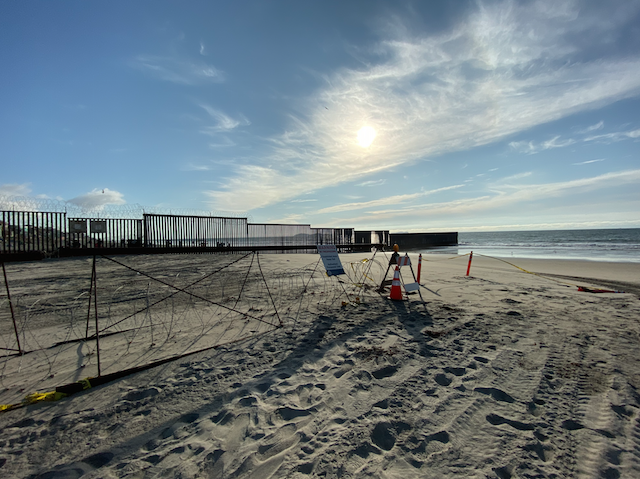
Story by Pete Shaw
Since declaring himself a candidate for the presidency of the United States, Republican Donald Trump has made clear his disdain for migrants. On the day he announced his candidacy, Trump declared that all Mexicans were criminals, particularly inclined toward rape and drug dealing. Trump quickly followed this by saying he assumed “some” of them were good people, and then went further to include other groups of people–all often stereotyped in the United States as having brown skin–including those from South and Central America, and as well from the Middle East.
Following his election, Trump began following through on campaign promises and rhetoric to ramp up official attacks on and persecution of immigrants, particularly those from south of the Mexico-US border. And while that persecution and the white supremacy from which it emanates has long been woven into the fabric of this country, the Trump Administration has significantly accelerated it beyond the anti-immigrant policies of the W. Bush and Obama presidencies that have been a point of agreement between the Republican and Democratic parties, separated only by rhetoric. Migrants and migrant communities in the United States have seen increased attacks against them, and the results of this greatly expanded crackdown have been horrifying, as seen, for example, in the photos of caged children at the Mexico-US border.
Migration and the persecution of migrants is not unique to the United States. Across the globe, particularly as capitalism goes through what many would call a cancer stage or its final throes, the oppression of migrants seems on the rise, both for those denied and granted entry to the countries they are seeking access.
Of course, migrants are also organizing and resisting. On Thursday January 23, a forum titled Building Communities in Times of Walls: Migrant Justice from PDX to the Border to Quito offered some insight into current conditions at the Mexico-US border as well as prospects for greater border solidarity and expanded grassroots migrant organizing. The meeting, hosted by the International Migrants Alliance-USA Chapter, consisted of two report backs from two recent delegations to the Mexico-US border and to Quito, Ecuador.
Raquel Barajas, Adrianne Sebastian, and Eric Vega visited the border between San Diego and Tijuana. Like many people, she had seen the news reports of overflowing detention centers, and the mass numbers of refugees and other people who had been displaced seeking asylum in the US. It was important, Barajas said, to witness what injustices were occurring. While the numbers may have been more vast than in Portland, she noticed a similarity between both places.
Barajas opened by stating, “One of the things throughout the border that we learned was that borders are not just limited to the border town or ports of entry.” Yes, the imaginary line drawn between Mexico and the United States is real, but its enforcement is not limited to the official demarcation. Go to any moderate sized city in the US, such as Portland, and you will find all the institutional apparatus for deciding to whom and how that border applies. For example, the Immigration and Customs Enforcement Agency (ICE) has offices and a prison in Portland (with its larger jail in Tacoma, Washington). And there is the Portland Immigration Court located in the heart of downtown, which falls under the jurisdiction of the US Department of Justice. Those institutions, Barajas noted, “employ intimidation and terror” on migrants.
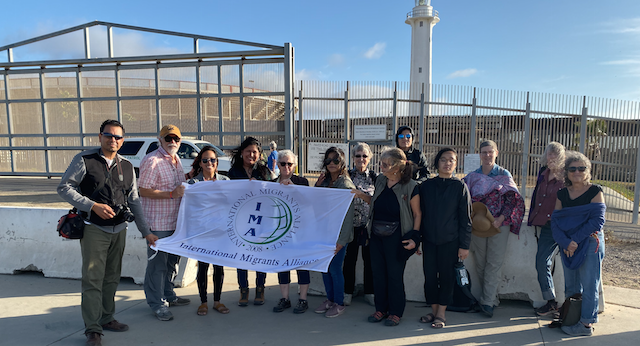
“What is happening in San Diego,” she said, “is also what is happening here in Portland. They may look different, but the agenda of the government is the same.”
While in San Diego, Barajas, Sebastian, and Vega met with an immigration attorney who spends most of his time consulting in Tijuana on Honduran and Mexican asylee cases. He described for them the conditions he has seen in Tijuana, estimating that about 35 shelters of varying capacities are helping house migrants, as well as the various reasons people from Mexico, and in particular Central America–from where the majority of those at the southern border seeking asylum come–are amassing in Tijuana. Leaving their homes behind in search of something safer and more secure, those migrants must endure horrors including forced disappearance by paramilitary forces that function as death squads, and militarized drug cartels. As well, due to the Trump Administration’s Migrant Protection Protocols (MPP)–known colloquially as the Remain in Mexico program–and its arrangements with the government of Guatemala, soon refugees, displaced people, and other migrants will be shipped from the Mexico-US border to Guatemala to await their immigration hearings. The Trump Administration wants to extend the program to include El Salvador and Honduras. These are the very countries many of these people are desperate to escape.
According to Human Rights First, under MPP, US Department of Homeland Security officers have turned back over 57,000 asylum seekers and migrants “to wait in danger in Mexico,” including sending at least 25,000 to the “notoriously dangerous state of Tamaulipas” which the US State Department considers a place about as safe as Afghanistan and Syria. Other data gathered by Human Rights First shows numerous reports of “rape, kidnapping, and other violent attacks against asylum seekers and migrants returned to Mexico under MPP,” while acknowledging that its count is “only the tip of the iceberg, as the overwhelming majority of returned individuals have not spoken with human rights investigators or journalists.”
Sebastian, who works with the IMA and Migrante Portland, also noted this discrepancy between reported and actual violence, and as well added the context of continuity to it. She stated that since 2007 there have been 40,000 cases of migrants being forcibly disappeared, but it is estimated that only 1 out of 7 of all disappearances are reported. With those disappearances and other horrors directly linked to US foreign and economic policies that compel many people to leave their homes, Sebastian urged people to make connections between what is happening at the border and holding the US government accountable, whether in San Diego, Portland, or anywhere else in the US. In particular, she noted that in cities like Portland and San Francisco, which have “semi-progressive” immigration courts, it is the responsibility of those doing deportation and defense work to understand and build solidarity with people in other areas, some not so progressive, who are doing the same work. That cooperation, she said, includes lending resources, strategizing together, and working to apply pressure to government officials who keep the system running.
Vega, of the Portland Immigrant Rights Coalition (PIRC) and the Sol Collective in Sacramento, California, noted the changing population of Tijuana, as well as the stark material needs of the people who have migrated there. “The composition of the refugee community in Tijuana is changing,” said Vega. “Historically you would say it is Latino or Mexican. Today people are from Myanmar, from Saudi Arabia, from Nigeria, from Haiti, from all around the world, so the demographic component of the refugees is changing in Tijuana. It is up to churches, it is up to social service agencies to go there and to provide direct emergency assistance. So the number I have is approximately 18,000 people that are there desperately needing assistance. The nurses saw problems with rashes, with asthma, with problems associated with not having proper housing, water, and food. They were describing children who were vacant-eyed.”
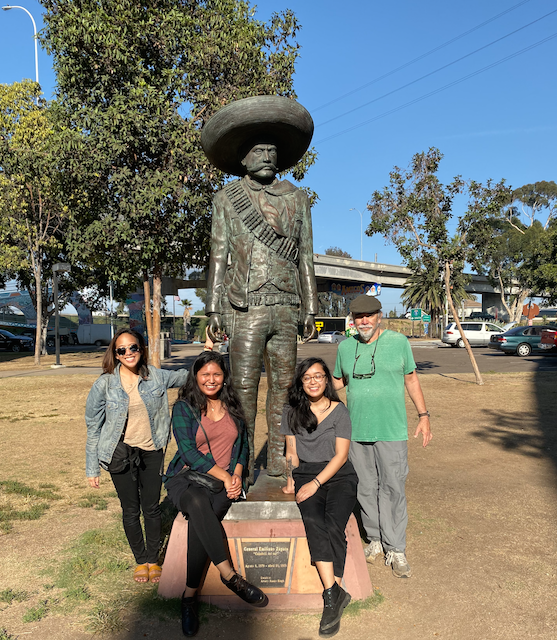
There is resistance. Vega spent a few hours at a conference in Tijuana where he met people from all over the world “to talk about the problem of borders that are not natural borders but are occurring everywhere.” One problem attendees noted was the “tremendous increase in digital hate” with people “flaming in ethnic and racial hate.” Part of the message of the conference, Vega said, was figuring out how to bring “some degree of civility to discourse around the world because so much of it is taking place on the computer.”
Barajas spotlighted the work of Border Angels, and in particular, the evolving nature of that work as the group responds to the quickly changing tactics of ICE and other enforcers of US immigration policy. Among their tactics of resistance include educational programs, water drops in the desert, outreach to day laborers, and leading “Caravans of Love” to shelters, as well as to immigration consultations in the US where migrants are in danger of being snatched up by ICE. The Caravans of Love also provide needed supplies for migrant families, working as a rapid response team, continuing to evolve “as this administration accelerates Trump’s agenda to deter folks at the border.” Likewise, groups in Portland fighting for migrants must evolve.
As an example, Barajas pointed out how Border Angels’ rapid response team morphed from its Deterring ICE program, which much like the Portland Immigrant Rights Hotline, was used to keep people aware of and ready to respond to ICE activity in the community. That activity in particular focused on the large scale raids that made headlines throughout the W. Bush and Obama Administrations. However, ICE changes its tactics, and relies less on these big raids that were once common.
“ICE is learning from everyone’s tactics,” Barajas told the audience. “They’re trying to change their tactics to fluster us. We have to change our tactics and act intentionally and not in crisis mode. We don’t know what the next thing will be that they do. They have money and they are full time staff.”
In turn, the rapid response team became a resource line for migrant and refugee communities whose most important need now, both in San Diego and Portland, as well as throughout the US, is getting legal representation.
While there is an increasing need for lawyers because of the amount of cases the community now has to fight, it is simultaneously increasingly difficult for migrants and their families to afford an immigration lawyer.
“This is where we have been able to respond, fundraising and crowdsourcing for families,” said Barajas. “This deportation and detention defense is compounded with the fact that if there are previous criminal charges that a migrant faces, there is a need for more criminal attorneys willing to also work with immigration lawyers, and the balance of meeting both requirements really requires community support and mobilization.”
Following their visit with Border Angels, the group went to Friendship Park, located on the coastal section of the Mexico-US border, between San Diego and Tijuana. Established when Richard Nixon was president, the park was supposed to be a place where families could reunite. At that time there was no wall. Only a simple barbed wire fence partitioned the countries. It was considered sacred ground, a place where families that had been separated or forced to migrate could spend time together.
Over the years, it has become defiled. The Clinton Administration’s Operation Gatekeeper militarized the westernmost reaches of the Mexico-US border, increasing Customs and Border Patrol surveillance of the area, and extending the border wall into the Pacific Ocean. The Obama Administration constructed a secondary wall while severely limiting the time families could spend together. Sebastian described the Clinton and Obama walls as creating a situation where people “could only touch pinkies to each other.”
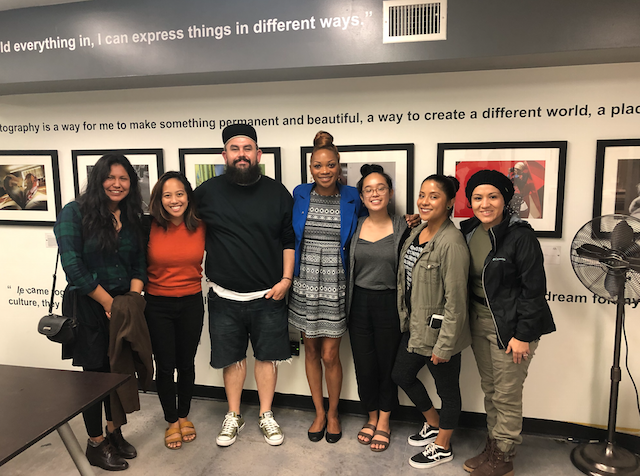
There is good money to be made from cruelty. Sebastian talked about organizers she met sharing how immigration and criminal law went hand in hand in “monetizing people’s suffering,” and how detention centers profited off of jailed migrants, both from government contracts and forcing prisoners to pay to use commissaries and telephones.
And there is also death in the wake of the cruelty of US immigration policies.
An old saying has it that if you build a 20 foot wall, someone will build a 21 foot ladder. It is a nice sounding aphorism, and it likely holds a few grains of truth. But the larger reality, as Sebastian said, is that “more border walls equals more border deaths.” Wall reinforcements and proposed expansions force many migrants to navigate the extremely hostile terrain of the desert or the marginally less dangerous Pacific water crossing putting them at risk for drowning. And in all cases, increased surveillance, expanded walls, and augmented militarization from government, paramilitaries, and narco traffickers result in more exploitation of those migrants who are not killed during their trek.
These dynamics of migration are not limited to the Mexico-US border. After Barajas, Sebastian, and Vega finished, Marco Mejia of The Migrant Collective and Benjamin, both of IMA-Portland talked about their November trip to the International Assembly of Migrants and Refugees (IAMR) in Quito, Ecuador. The IAMR is the IMA’s counterpoint to the Global Forum on Migration and Development (GFMD) which views migration through the concerns of governments and capitalism. Instead, the IAMR brings together grassroots organizations, migrant workers, churches, and various social movements, offering an alternative to what Mejia described as the GFMD’s tendency “to look at migration as a tool for development at the expense of migrants and their families, bringing together groups including churches, governments, and NGOs that essentially work for and represent the objectives of the corporations.” Contrarily, the goal of the IAMR is to bring forth the concerns of migrants, refugees, and displaced persons whose demands have not been collected by the GFMD.
The IAMR was purposely held in Quito so it would provide a contrast with the GFMD’s meeting that was to be held there at the same time. However, due to an October popular uprising by the Ecuadorian people in response to the International Monetary Fund’s austerity economics package embraced by President Lenín Moreno, and the subsequent clampdown by Ecuador’s police, the GFMD postponed its meeting until January of this year.
The groups and people involved with the IAMR could not decamp and reschedule so easily. Besides, as Mejia said, “We needed to do what we needed to do: come together in solidarity and organize and see how we can continue the struggle for migrant justice.” Nonetheless, there was a feeling of unease. Benjamin noted how due to security concerns, particularly worries about paramilitary groups and government backlash, the location of the meeting kept changing. Eventually, the University of Quito was settled upon, a nice homecoming for Mejia who was once a student there.
Mejia described the gathering as being largely for migrants coming to Ecuador, especially Colombians and Venezuelans. Ecuador, he noted, receives among the largest number of refugees in the world.
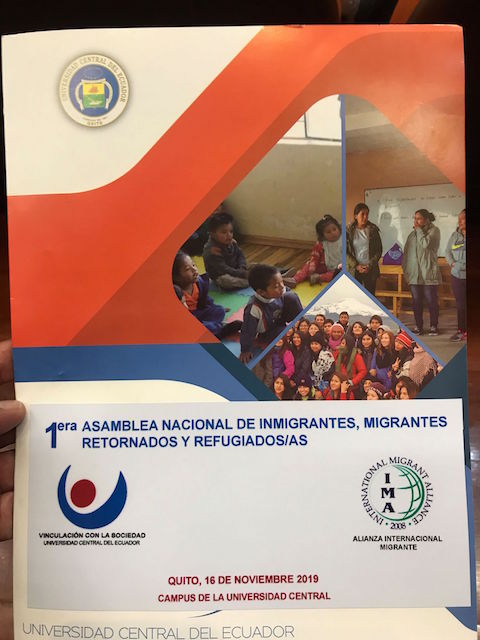
Mejia told how in the past 3 years, over 1.4 million Venezuelans have entered Ecuador, adding to the nearly 240,000 who were already in the country. As well, more than a half million Colombians migrated to Ecuador during the armed conflict in Colombia that lasted for 50 years, making Ecuador one of the largest recipients of refugees in the world. That makes some sense as throughout much of its history, South America, like Central America, has been ravaged by wars and dictatorships imposed upon it by the United States and other global capitalist powers, which generated hundreds of thousands of displaced people.
“The perspective was to understand and see what is happening with migrants coming to Ecuador, as well as migrants and their families that leave Ecuador, migrating to other places,” said Mejia. “It was also for migrants, immigrants especially, that have been deported and are returning to Ecuador. And to recognize the situation of displaced people internally, and also regionally, and refugees. It was an opportunity for all the participants, in one hand, to listen to each other, have a dialogue, share experiences and perspectives and unite the struggle in solidarity, and in the other hand, to develop an analysis on the issues of imperialism, forced migration and human trafficking.”
Mejia emphasized the importance of recognizing that the regulation of migration is a global phenomena, and it is not by accident. Rather, it is part of what is loosely called the neoliberal economic model. For example, while a global economic system that adhered to the revered father of capitalism, Adam Smith, would allow for borderless passage of both labor and capital, so-called free trade agreements allow for unfettered capital but make little allowance for similar movement of workers in response to the effects of the free movement of capital.
“Neoliberal globalization is being forced on us in all different aspects of our life, in everything, and migration is one of those,” said Mejia. “There’s treaties now that (the US has) signed with Mexico, with Guatemala, and with El Salvador to see how they can stop the migrants. But there’s a few that make it because, of course, the system needs human bodies to come, and they come into much worse conditions, as vulnerable workers to be exploited, without rights, criminalized and dehumanized. That was important, to understand that the biggest root cause of immigration right now is capitalism.”
While at the IAMR, Mejia and Benjamin participated in an event with Churches Witnessing with Migrants (CWWM) which bills itself as “a tripartite body of equals that includes migrants and representatives of migrant-serving and faith-based organizations from various faith traditions.” Benjamin described the meeting as compelling and the CWWM as “hugely useful to each other about educating each other about the different work that different groups were doing.” In an example of the global reach of the conversation, Benjamin described talking with a German archbishop and a Canadian woman who was working with Somalian refugees.
But Antonio Arizaga, vice president of the IMA, wanted to push further. Benjamin said Arizaga gathered up the IMA members and told them the IMA’s contribution would be to politicize the CWWM’s conversation.
“I think that was the good that we did there,” said Benjamin, “demanding and forcing the conversation of capitalism being inherently exploitative, neoliberal economic policies creating unlivable wages, and consumers in the global north who are eagerly purchasing goods that are exploiting people.”
Ultimately, Mejia said, that politicization must go hand in hand with migrants building and leading resistance organizations that in turn must work in solidarity with other migrant led organizations. He noted that while anti-immigrant sentiment and capitalism are oppositions, so to can be “our own peers and allies” whom Mejia described as sometimes “tokenizing us and using us.” What Mejia seemed to mean was that for many people who support migrant rights, their work is often more about “saving and helping refugees”–which he noted was important and the right thing to do–but that further education was needed so “we bring all of us to the same level, same playing field. That I help you and you help me, and we build together a project that’s going to change this world.”
Mejia talked about how that very big challenge exists here in Portland. “How do groups and allies allow migrants to be the ones that lead the movement? We have groups and people that are committed, but they are not migrants, or don’t have migrant members and leaders.”
In November 2018 a migrant caravan of people from Guatemala and Honduras arrived in Tijuana. Some of those Hondurans, Sebastian noted during a question and answer session the closed out the forum, had been organizers for social justice movements back home, and upon reaching to Mexico-US border, they again began applying their skills. At the time what was coming out was xenophobic and racist rhetoric in popular media, and so Honduran social organizers started to list their demands, but also created the Berta Caceres Bill which calls for cutting US aid to Honduras.”
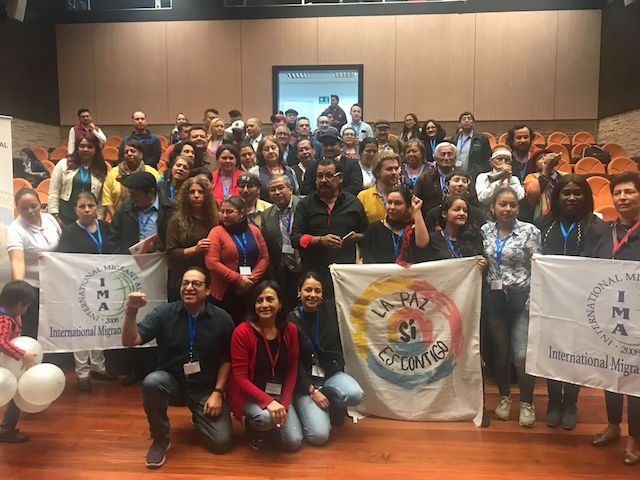
“When they started organizing in Tijuana,” said Sebastian, “they saw the conditions were bad and that they needed to organize and also to tell the international community why they were organizing.”
Their work has resulted in people organizing in the US, pushing people to push their legislators to bring the bill forward.
Mejia said, “We need an understanding of what migrant justice movement building is, and what are the roles of allies.”
The challenge is local, but it is also global.
“It’s important that we organize locally,” said Mejia. “It’s important that we organize with the migrants in their places of destinations, and also it’s important to be organized in their places of origin. Migration is happening everywhere, and it is imperative that we are organized and promote organizing, with a big spirit of solidarity. And we need to think creatively how we build that. It is very real throughout our world, these anti-immigrant and neo-Nazi waves. It’s not happening just in the United States or in Germany or in Europe. It’s in Ecuador, it’s in Brazil, it’s in Venezuela, in Bolivia.”
“It’s everywhere. It’s in Portland. How do we fight a system that is at that level? Building alliances between all social movements to confront it is very important.”






